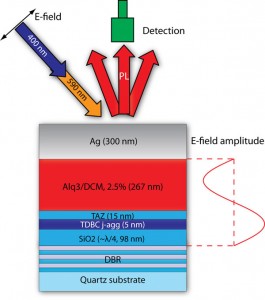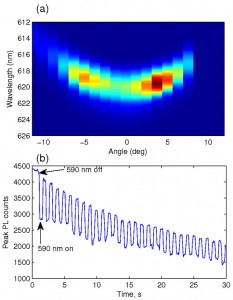Ultra-fast Laser Modulation Mediated by Strong Light-matter Coupling
Optical computing has the potential to create a paradigm shift in the way information is transmitted and manipulated by creating all-optical data networks and computational circuits with almost unlimited bandwidth and unprecedented energy-efficiency. However, this long-standing dream has thus far been difficult to achieve due to a lack of appropriate material sets, light-matter interactions, and device design necessary to create the optical components that are fast, highly energy-efficient, and capable of being integrated into a larger photonic system. Here we present a micron-scale laser structure with output that is modulated at THz frequencies and with ultra-low energies. The lasing medium emission from the cavity is modulated by the presence of a highly absorptive J-aggregate material that is strongly coupled to the cavity [1] [2]. The devices consist of a dielectric mirror, followed by a thermally evaporated layer of the dye DCM (the lasing material) and a 5-nm J-aggregate thin film that is resonantly coupled to the cavity. The cavity is capped with a thermally evaporated silver mirror. The structure is shown in Figure 1.
The cavity is excited non-resonantly with 150-fs pulses (from the pump), which causes lasing emission from the DCM at 600 nm. The emission shows an unusual conical dispersion pattern (Figure 2a) due to the strongly-coupled J-aggregate material in the cavity. A second (gate) pulse, which is resonant with the J-aggregate absorption, is delivered to the sample at a variable time relative to the pump pulse. Upon the excitation of the J-aggregate layer with the gate pulse, the lasing emission is quenched up to 25% (Figure 2b). The modulation of the lasing output occurs only when the pump-gate pulse delay is < 1 ps, permitting operating frequencies of up to 1 THz. The gate pulse energy density required for modulation was ~ 1 fJ/µm2. This micro-scale laser modulator is a demonstration of a potentially new class of organic-based, low-power, ultra-fast photonic circuit components. Currently, the role of strong light-matter coupling in the modulation of the lasing is being investigated.
References
- M. S. Bradley, J. R. Tischler, and V. Bulovic, “Layer-by-layer J-aggregate thin films with a peak absorption constant of 10(6) cm(-1),” Advanced Materials, vol. 17, pp. 1881-1886, 2005. [↩]
- Tischler et al. “Solid state cavity QED: Strong coupling in organic thin films,” Organic Electronics, vol. 8, pp. 94-113 (2007). [↩]

